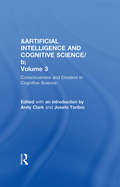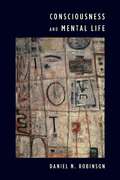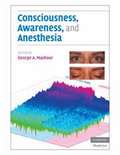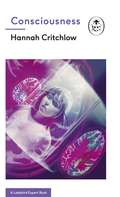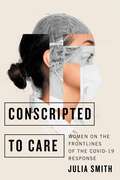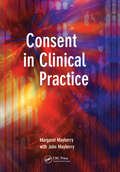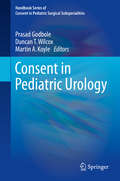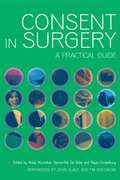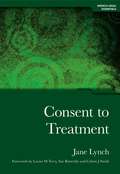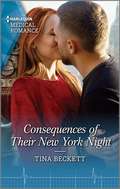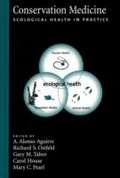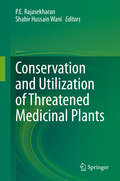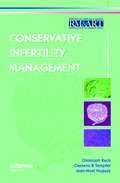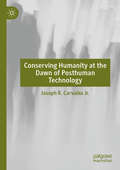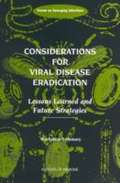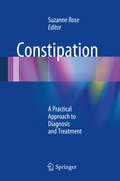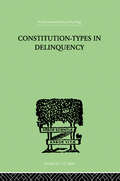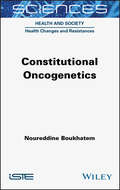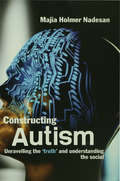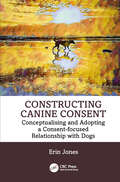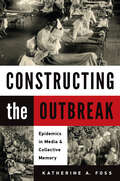- Table View
- List View
Consciousness and Emotion in Cognitive Science: Conceptual and Empirical Issues (Artificial Intelligence And Cognitive Science Ser.)
by Andy Clark Josefa ToribioFirst published in 1998. Routledge is an imprint of Taylor & Francis, an informa company.
Consciousness and Mental Life
by Daniel N. RobinsonIn recent decades, issues that reside at the center of philosophical and psychological inquiry have been absorbed into a scientific framework variously identified as "brain science," "cognitive science," and "cognitive neuroscience." Scholars have heralded this development as revolutionary, but a revolution implies an existing method has been overturned in favor of something new. What long-held theories have been abandoned or significantly modified in light of cognitive neuroscience? Consciousness and Mental Life questions our present approach to the study of consciousness and the way modern discoveries either mirror or contradict understandings reached in the centuries leading up to our own. Daniel N. Robinson does not wage an attack on the emerging discipline of cognitive science. Rather, he provides the necessary historical context to properly evaluate the relationship between issues of consciousness and neuroscience and their evolution over time. Robinson begins with Aristotle and the ancient Greeks and continues through to René Descartes, David Hume, William James, Daniel Dennett, John Searle, Richard Rorty, Hilary Putnam, and Derek Parfit. Approaching the issue from both a philosophical and a psychological perspective, Robinson identifies what makes the study of consciousness so problematic and asks whether cognitive neuroscience can truly reveal the origins of mental events, emotions, and preference, or if these occurrences are better understood by studying the whole person, not just the brain. Well-reasoned and thoroughly argued, Consciousness and Mental Life corrects many claims made about the success of brain science and provides a valuable historical context for the study of human consciousness.
Consciousness and Mental Life
by Daniel N. RobinsonIn recent decades, issues that reside at the center of philosophical and psychological inquiry have been absorbed into a scientific framework variously identified as "brain science," "cognitive science," and "cognitive neuroscience." Scholars have heralded this development as revolutionary, but a revolution implies an existing method has been overturned in favor of something new. What long-held theories have been abandoned or significantly modified in light of cognitive neuroscience? Consciousness and Mental Life questions our present approach to the study of consciousness and the way modern discoveries either mirror or contradict understandings reached in the centuries leading up to our own. Daniel N. Robinson does not wage an attack on the emerging discipline of cognitive science. Rather, he provides the necessary historical context to properly evaluate the relationship between issues of consciousness and neuroscience and their evolution over time. Robinson begins with Aristotle and the ancient Greeks and continues through to René Descartes, David Hume, William James, Daniel Dennett, John Searle, Richard Rorty, Hilary Putnam, and Derek Parfit. Approaching the issue from both a philosophical and a psychological perspective, Robinson identifies what makes the study of consciousness so problematic and asks whether cognitive neuroscience can truly reveal the origins of mental events, emotions, and preference, or if these occurrences are better understood by studying the whole person, not just the brain. Well-reasoned and thoroughly argued, Consciousness and Mental Life corrects many claims made about the success of brain science and provides a valuable historical context for the study of human consciousness.
Consciousness and Science Fiction (Science and Fiction)
by Damien BroderickScience fiction explores the wonderful, baffling and wildly entertaining aspects of a universe unimaginably old and vast, and with a future even more immense. It reaches into that endless cosmos with the tools of rational investigation and storytelling. At the core of both science and science fiction is the engaged human mind--a consciousness that sees and feels and thinks and loves. But what is this mind, this aware and self-aware consciousness that seems unlike anything else we experience? What makes consciousness the Hard Problem of philosophy, still unsolved after millennia of probing? This book looks into the heart of this mystery - at the science and philosophy of consciousness and at many inspiring fictional examples - and finds strange, challenging answers.The book's content and entertaining style will appeal equally to science fiction enthusiasts and scholars, including cognitive and neuroscientists, as well as philosophers of mind. It is a refreshing romp through the science and science fiction of consciousness.
Consciousness, Awareness, and Anesthesia
by George A. MashourHypnosis, amnesia, and immobility are three major therapeutic endpoints of general anesthesia. In one to two cases out of a thousand, hypnosis and amnesia are not achieved - often leaving a patient immobile but capable of experiencing and remembering intraoperative events. Awareness during general anesthesia is one of the most dreaded complications of surgery and is feared by patients and clinicians alike. Despite many advances in the field, there are also a number of unresolved questions that persist. Some of the difficulties in the detection and prevention of awareness during anesthesia relate to the underlying complexities of the neuroscientific basis of consciousness. Consciousness, Awareness, and Anesthesia is a multidisciplinary approach to both the scientific problem of consciousness and the clinical problem of awareness during general anesthesia. An international cadre of authors with expertise in anesthesiology, neurobiology, and philosophy provides a cutting-edge perspective. No other book on the subject has drawn from such a breadth of scholarship.
Consciousness: A Ladybird Expert Book (The Ladybird Expert Series #29)
by Hannah CritchlowPart of the ALL-NEW LADYBIRD EXPERT SERIES.____________Are other animals, or even plants, conscious?Can we create conscious robots?Are we able to assume the consciousness of someone else?We all experience the world differently.REALITY is shaped by our individual memories.So we respond to THE WORLD in our own ways.Our UNIQUE EXPERIENCE underpins what it means to be CONSCIOUS.This raises so many questions such as where does consciousness live? And what is it for?Discover the answers and more inside Hannah Critchlow's Ladybird Expert - Consciousness, the thrilling and accessible account that explains what it means to be conscious - from what defines it, to questioning the existence of free will.
Conscripted to Care: Women on the Frontlines of the COVID-19 Response
by Julia SmithWith the vast majority of healthcare and social workers identifying as women, the vanguard of the COVID-19 response was distinctly gendered. In Conscripted to Care Julia Smith introduces us to the women who faced the worst effects of the pandemic and the inequities it exposed. Through clear prose and fascinating critical analysis, she documents their largely unseen contributions and sacrifices, both professional and domestic.Drawing on interviews and focus groups with nearly two hundred women from a range of backgrounds and occupations, Smith reveals how structural inequality put women on the frontlines of the pandemic response, yet with inadequate resources and little voice in decision-making. Women shouldered not only the triple burden of paid work, unpaid care, and mental load, but also increased emotional labour. While some women were categorized as “essential,” others remained in the shadows. All faced unsustainable workloads, moral distress, and burnout while continuing to demand better services for those in their care.An analysis of Canada’s COVID-19 response from the perspective of those who staffed it, Conscripted to Care presents crucial lessons for those interested in public health and how it relates to gender and economic equality, as well as public policy.
Consent in Clinical Practice
by John Mayberry Margaret MayberryThis is a practical guide to successfully achieving a fully computerised system in primary care. It shows how to source a primary care clinical system that does what you need it to do and how to use it effectively. The book is easy to read with numerous examples and copies of useful documents throughout. Helpful features include charts to map progress at a glance icons to point out www links details of additional resources for further information and highlights cautions and key points are highlighted. The author has drawn together ten years' practical experience working with over 200 practices and incorporates the best national and international expertise. This is an essential guide for GPs practice nurses managers and all members of the primary care team. For downloadable resources accompanying this book click here
Consent in Pediatric Urology (Handbook Series of Consent in Pediatric Surgical Subspecialities)
by Duncan T. Wilcox Martin A. Koyle Prasad GodboleThis comprehensive handbook of consent in surgical subspecialities is dedicated to the risks and complications that a child needs to be consented for in the vast majority of pediatric surgical procedures with evidence base and outcomes. The chapters address common and rare complications encountered in pediatric subspeciality practice which clinicians need to be aware of to allow them to take fully informed consent. The contributors are renowned for their expertise in pediatric urology and provide evidence and outcome based areas for consent in the first book of the series: 'Consent in Pediatric Urology'.
Consent in Surgery: A Practical Guide (Radcliffe Ser.)
by Roba Khundkar Silva Samantha De Rajat ChowdurySurgeons have a duty to provide accurate information before asking for consent for surgery, and patients are increasingly interested in obtaining as much information as possible regarding their procedures. Consent in Surgery addresses these vital areas, outlining the consent process for common surgical procedures, including indications, benefits, risks/complications, alternative treatment options, a brief description of each procedure and summaries of the relevant scientific evidence. It contains procedures from subspecialties including cardiothoracic surgery, neurosurgery, general surgery, paediatric surgery, plastic and reconstructive surgery, trauma and orthopaedic surgery, otolaryngology and urology. The procedures included fall within the Intercollegiate Surgical Curriculum Project and MRCS syllabi, and are assessed during higher specialist training, making the book an essential revision and interview preparation tool. 'Helpful to all surgeons in their general approach to this issue and to those in each of the specialties with regard to specific operations.' - From the Foreword by John Black 'A welcome guide, written by authoritative voices and of digestible length. This volume on consent should be in every ward library, close to hand for the ever more rapidly changing teams managing surgical patients.' - From the Foreword by Tim Goodacre
Consent to Treatment: Medico-legal Essentials
by Jane LynchAn understanding of the law and the way in which it impacts upon roles, responsibilities and care is a vital component in everyday healthcare. The law of consent is particularly complex, and its inadvertent misinterpretation, misapplication or maladministration by health professionals has led to an increasing number of legal claims for compensation. This book explains the legal issues around consent to treatment in England and Wales simply and straightforwardly. It uses real-life examples to set out the professional obligations, basic principles of consent and detailed information on each area, enabling health professional to approach consent methodically and to ensure that it is validly obtained and recorded. 'Explains the complexities of consent in a practical and straightforward way making a difficult and often complex subject easy to understand. In addition it is a useful handbook that health professionals at all levels can refer to as an everyday text to help guide them through the intricacies of the topic.' - From the Foreword by Colum J Smith 'This book is invaluable to health care professionals and could help prevent them from attending court defending the care they have inadvertently provided.' - From the Foreword by Sue Battersby 'A very useful book for healthcare professionals of all kinds to refer to' - From the Foreword by Louise M Terry
Consequences of Their New York Night: Consequences Of Their New York Night (new York Bachelors' Club) / The Trouble With The Tempting Doc (new York Bachelors' Club) (New York Bachelors' Club #1)
by Tina BeckettAn irresistible flingthat changed his life forever…What&’s the key to a happy life? Well, for relationship-weary Dr. Kaleb, it&’s simple… Keep love out of the equation! But when diagnostician Nicola is introduced as his new colleague, life gets complicated. Why? Nicola is the beautiful stranger Kaleb spent one incredible night with—and couldn&’t forget! Yet, it&’s another unexpected arrival—in nine months&’ time!—that will truly shake up Kaleb&’s world…A New York Bachelors' Club novel New York Bachelors&’ Club duetBook 1 - Consequences of Their New York NightBook 2 – The Trouble with the Tempting Doc&“Tina Beckett definitely followed through on the premise and managed to infuse just the right amount of angst and passion to keep me glued to the pages of Miracle Baby for the Midwife from beginning to end.&”-Harlequin Junkie&“This story is Ms. Beckett at her best. Really, it&’s a charming and delightful story…. Overall, Ms. Beckett has delivered a heart-warming tale in this book…where the chemistry between this couple was strong right the moment they come face-to-face for the first time in years; the romance was delightful and well worth the wait….&”-Harlequin Junkie on A Christmas Kiss with her Ex-Army Doc
Conservation Medicine: Ecological Health in Practice
by Carol House Richard Ostfeld Gary Tabor Mary Pearl A. AguirreConservation medicine is an emerging discipline, focussing on the intersection of ecosystem health, animal health, and human health. Work in the biomedical and veterinary sciences is now being folded into conservation biology; to explore the connections between animal and human health; trace the environmental sources of pathogens and pollutants; develop an understanding of the ecological causes of changes in human and animal health; and understand the consequences of diseases to populations and ecological communities.Conservation Medicinedefines this new discipline. It examines ecological health issues from various standpoints, including the emergence and resurgence of infectious disease agents; the increasing impacts of toxic chemicals and hazardous substances; and the health implications of habitat fragmentation and degradation and loss of biodiversity. It will provide a framework to examine the connections between the health of the planet and the health of all species and challenge practitioners and students in the health sciences and natural sciences to think about new, collaborative ways to address ecological health concerns.
Conservation and Utilization of Threatened Medicinal Plants
by Shabir Hussain Wani P. E. RajasekharanMedicinal plants are globally valuable sources of herbal products. Plant-based remedies have been used for centuries and have had no alternative in the western medicine repertoire, while others and their bioactive derivatives are in high demand and have been the central focus of biomedical research. As Medicinal plants move from fringe to mainstream with a greater number of individuals seeking treatments free of side effects, considerable attention has been paid to utilize plant-based products for the prevention and cure of human diseases. An unintended consequence of this increased demand, however, is that the existence of many medicinal plants is now threatened, due to their small population size, narrow distribution area, habitat specificity, and destructive mode of harvesting. In addition, climate change, habitat loss and genetic drift have further endangered these unique species. Although extensive research has been carried out on medicinal and aromatic plants, there is relatively little information available on their global distribution patterns, conservation and the associated laws prevailing.This book reviews the current status of threatened medicinal plants in light of increased surge in the demand for herbal medicine. It brings together chapters on both wild (non-cultivated) and domestic (cultivated) species having therapeutic values. Thematically, conventional and contemporary approaches to conservation of such threatened medicinal plants with commercial feasibility are presented. The topics of interest include, but not limited to, biotechnology, sustainable development, in situ and ex situ conservation, and even the relevance of IPR on threatened medicinal plants. We believe this book is useful to horticulturists, botanists, policy makers, conservationists, NGOs and researchers in the academia and the industry sectors.
Conservative Infertility Management (Reproductive Medicine and Assisted Reproductive Techniques Series)
by Christoph Keck Clemens B. Tempfer Jean Noel HuguesThe aim of this book is to fill the gap between the standard textbooks of obstetrics & gynecology - which do not cover (conservative) infertility treatment - and the specialized textbooks on ART - which don't address topics such as ovulation induction/IUI and the typical treatment of disorders associated with infertility, such as hyperandrogenism a
Conservatorship: Inside California’s System of Coercion and Care for Mental Illness
by Alex V. BarnardIs involuntary psychiatric treatment the solution to the intertwined crises of untreated mental illness, homelessness, and addiction? In recent years, politicians and advocates have sought to expand the use of conservatorships, a legal tool used to force someone deemed “gravely disabled,” or unable to meet their needs for food, clothing, or shelter as a result of mental illness, to take medication and be placed in a locked facility. At the same time, civil liberties and disability rights groups have seized on cases like that of Britney Spears to argue that conservatorships are inherently abusive.Conservatorship is an incisive and compelling portrait of the functioning—and failings—of California’s conservatorship system. Drawing on hundreds of interviews with professionals, policy makers, families, and conservatees, Alex V. Barnard takes readers to the streets where police encounter homeless people in crisis, the locked wards where people receiving treatment are confined, and the courtrooms where judges decide on conservatorship petitions. As he shows, California’s state government has abdicated authority over this system, leaving the question of who receives compassionate care and who faces coercion dependent on the financial incentives of for-profit facilities, the constraints of underresourced clinicians, and the desperate struggles of families to obtain treatment for their loved ones.This book offers a timely warning: reforms to expand conservatorship will lead to more coercion but little transformative care until government assumes accountability for ensuring the health and dignity of its most vulnerable citizens.
Conserving Humanity at the Dawn of Posthuman Technology
by Joseph R. Carvalko Jr.This volume examines the latest scientific and technological developments likely to shape our post-human future. Using a multidisciplinary approach, the author argues that we stand at the precipice of an evolutionary change caused by genetic engineering and anatomically embedded digital and informational technologies. The author delves into current scientific initiatives that will lead to the emergence of super smart individuals with unique creative capacities. He draws on technology, psychology and philosophy to consider humans-as-they-are relative to autonomy, creativity, and their place in a future shared with ‘post humans.’ The author discusses the current state of bioethics and technology law, both which policymakers, beset by a torrent of revolutionary advances in bioengineering, are attempting to steer. Significantly, Carvalko addresses why we must both preserve the narratives that brought us to this moment and continue to express our humanity through, music, art, and literature, to ensure that, as a uniquely creative species, we don’t simply vanish in the ether of an evolution brought about by our own technology.
Considerations for Viral Disease Eradication: Lessons Learned and Future Strategies
by Forum on Emerging InfectionsSince smallpox eradication, the science of eradication has changed and with it, our definitions of what diseases are possible to eradicate. However, eradication must not beget complacency. As has been learned from past control or eradication attempts with a variety of viral diseases, from yellow fever to influenza, accidental or intentional reintroduction is a real threat -- one that could strike anywhere and for which we need to be fully prepared. The criteria for assessing eradicability of polio, measles, and other viral infections have been debated extensively. With the elimination and eradication of several viral diseases on the horizon, issues surrounding the cessation of immunization activities become exceedingly important. In an effort to better understand the dynamics of disease eradication and post--immunization policies, the Institute of Medicine Forum on Emerging Infections hosted a two-day workshop (February 1--2, 2001) on The Consequences of Viral Disease Eradication. This book explores the principles underlying the biological challenges, medical interventions, the continuing research agenda, and operational considerations for post--immunization strategies for vaccine--preventable viral diseases, and highlights important efforts that may facilitate wise decision making.
Considerations for a Post-COVID-19 Technology and Innovation Ecosystem in China (Disaster Risk Reduction)
by Rajib Shaw Jinling Hua Bismark Adu GyamfiCOVID-19 has made differential impacts on countries and communities around the world. China, where COVID-19 started, has developed and utilized different types of technologies, including both traditional and disruptive technologies, to address the pandemic risks. Also, there have been many innovations in applying technologies in different contexts during the pandemic as well as in the post-pandemic recovery and preparedness aspects. This book covers some of these technological developments as well as the governance mechanisms for developing a technology and innovation ecosystem in a post-COVID-19 context in China. The book also explores the experiences and lessons learned from different types of technologies and their implementation in the post-COVID-19 period and highlights how they can be useful to prepare for future calamities.
Constipation: A Practical Approach to Diagnosis and Treatment
by Suzanne RoseConstipation: A Practical Approach to Diagnosis and Treatment serves as an unmet resource for physicians and other health care providers, including trainees and students, who see patients with constipation. The text reviews pathophysiologic mechanisms and details evaluation and management strategies. The volume also enables the reader to identify epidemiologic factors and quality of life parameters for patients with constipation, discuss differences in pathophysiologic mechanisms for different etiologies of constipation, recognize primary causes of constipation, and assess special considerations related to the symptom of constipation including presentations in the elderly, in pregnant women, in patients with systemic diseases, and patients with a history of abuse. Written by thought leaders and recognized experts in gastrointestinal motility and medical education, Constipation: A Practical Approach to Diagnosis and Treatment is of great value and utility for gastroenterologists, primary care physicians, gynecologists, nurse practitioners, physician's assistants, as well as fellows and residents.
Constitution-Types In Delinquency: PRACTICAL APPLICATIONS AND BIO-PHYSIOLOGICAL FOUNDATIONS OF (International Library Of Psychology Ser.)
by Willemse, W AFirst published in 1999. Routledge is an imprint of Taylor & Francis, an informa company.
Constitutional Oncogenetics
by Noureddine BoukhatemIn the age of genomics, oncogenetics is a growing discipline. It is defined as the identification and management of families where there is a suspected hereditary risk of cancer. This relatively new discipline is part of a modern medicine that aims to be both preventive and predictive. Constitutional Oncogenetics gives precise descriptions of the main syndromes that cause a predisposition for cancer. The first part examines the most common syndromes in the majority of the world, including the heightened hereditary risk of breast and ovarian cancer and Lynch syndrome. The second part introduces less common infracentesimal syndromes, such as Bloom syndrome and Fanconi syndrome. This book is intended for oncogenetic practitioners and other specialists, as well as medical students.
Constructing Autism: Unravelling the 'Truth' and Understanding the Social
by Majia Holmer NadesanAutism is now considered to be one of the most common developmental disorders today, yet 100 years ago the term did not exist. This book examines the historical and social events that enabled autism to be identified as a distinct disorder in the early twentieth century. The author, herself the mother of an autistic child, argues that although there is without doubt a biogenetic component to the condition, it is the social factors involved in its identification, interpretation and remediation that determine what it means to be autistic. Constructing Autism explores the social practices and institutions that reflect and shape the way we think about autism and what effects this has on autistic people and their families. Unravelling what appears to be the ‘truth’ about autism, this informative book steps behind the history of its emergence as a modern disorder to see how it has become a crisis of twenty-first century child development.
Constructing Canine Consent: Conceptualising and adopting a consent-focused relationship with dogs
by Erin JonesThe concept of canine consent is far more than simply a buzzword in modern dog training practices. In its current form, consent is a distinctly human concept, designed by humans and for humans. Looking beyond species boundaries can help us not only consider concepts of canine consent and autonomy, but it can also help us to apply these concepts in our everyday interactions with dogs, which is fundamental for any professional working with dogs as well as for everyday dog caregivers. This canine-indexed definition of consent includes a model of five major categories: Touch/interaction-based consent, cooperative care using learned consent behaviours, activity consent, consent-based learning, and substitutive consent. These categories involve a two-way communication system, integration of salient choices, teaching consent behaviours and incorporating existing training protocols that adhere to the Humane Hierarchy of best practices, and an evaluation of dependent decision-making in extenuating circumstances. This book aims to merge the existing literature and new understandings about canine consent to paint a complete picture. It will challenge the current expectations of dogs and dog behaviour in our society with an intention of considering their perspectives, experiences, and emotional needs. It will be important reading for veterinary professionals, dog trainers and behaviourists, those involved in work with therapy dogs, and anybody working with or caring for dogs.
Constructing the Outbreak: Epidemics in Media & Collective Memory
by Katherine A. FossWhen an epidemic strikes, media outlets are central to how an outbreak is framed and understood. While reporters construct stories intended to inform the public and convey essential information from doctors and politicians, news narratives also serve as historical records, capturing sentiments, responses, and fears throughout the course of the epidemic.Constructing the Outbreak demonstrates how news reporting on epidemics communicates more than just information about pathogens; rather, prejudices, political agendas, religious beliefs, and theories of disease also shape the message. Analyzing seven epidemics spanning more than two hundred years—from Boston's smallpox epidemic and Philadelphia's yellow fever epidemic in the eighteenth century to outbreaks of diphtheria, influenza, and typhoid in the early twentieth century—Katherine A. Foss discusses how shifts in journalism and medicine influenced the coverage, preservation, and fictionalization of different disease outbreaks. Each case study highlights facets of this interplay, delving into topics such as colonization, tourism, war, and politics. Through this investigation into what has been preserved and forgotten in the collective memory of disease, Foss sheds light on current health care debates, like vaccine hesitancy.
